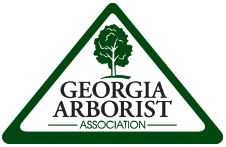Brittle Cinder Fungus (Kretzschmaria deusta)
By Logan House, ISA Board Certified Master Arborist. President, Georgia Arborist Association
If you have ever noticed a crusty, black growth at the base of your tree, your tree may have what many brittle cinder fungus (Kretzschmaria deusta). This fungus may at first look like a smooth lichen growth with a light gray to white color. These structures often mature to a burnt, brittle, bubbly texture that can be missed on casual inspections. This mature form might look like charred wood or other burnt material. It may also produce dark, bleeding cankers that may look like a Phytophthora infection. The color and texture of young infections may also be confused with Hypoxylon, another serious fungal pathogen. Since it is often low-growing and inconspicuous, you may miss Kretzschmaria under landscaping, leaf litter, mulch, or pine straw at the base of your tree. This wood decay fungus can weaken trees from the inside out and poses a serious risk to trees. Early detection is key to maintain long-term health and safety of your landscape.
What does brittle cinder do?
Kretzschmaria deusta is a fungal pathogen categorized as a “white rot”. However, unlike many white rots, Kretzschmaria primarily target the cellulose component of wood, leaving behind a high proportion of the rigid but brittle lignin. The wood of the tree often appears to be relatively sound and intact because of the pattern of decay. In many cases, this sort of decay can increase the likelihood of the infected tree snapping at or near the infection site. In addition to colonizing the heartwood of a tree, it can also infect and degrade the structural root plate and cause whole tree failure due to loss of wood strength. Kretzschmaria can continue to “eat” the tree after it is dead too, so you may find fruiting bodies on deadwood around your property.
What causes brittle cinder fungus?
Kretzschmaria reproduces through airborne spores and is suspected to spread through root-to-root contact from infected trees. Open wounds on the tree can provide infection sites for Kretzschmaria spores to colonize your tree. Proper pruning techniques should be employed to maintain proper tree health and limit these sorts of infection where possible. Avoid planting new trees in the root zone of actively infected trees.
Remember that the “mushroom” you see from a fungus, in this case the crusty-charcoal growths, are just the fruiting body the fungus uses to reproduce. Much like the apple on your apple tree, a mushroom is just the means by which many fungi reproduce. The actual organism of interest is in the wood of the tree and removal of the fungal fruiting body (the crusty stuff) will not stop disease progression.
Is my tree at risk?
As with all tree diseases, prevention is the best cure. Proper tree care can reduce your trees likelihood of contracting Kretzschmaria in the first place. Avoid mechanical damage and remember that string trimmers can damage trees considerably. This is especially an issue for younger, newly installed trees. Kretzchmaria is found on hardwoods, especially beeches (Fagus spp.) and maples (Acer spp.) but can also be found on oaks (Quercus spp.), birches (Betula spp.) and apples (Malus spp.), among other species.
What to do if you suspect your tree has brittle cinder fungus
Contact an ISA Certified Arborist to confirm the infection and perform a tree risk assessment.
Once positively identified, you may consider removal of the fruiting body to limit spread of the pathogen. The Georgia Arborist Association is not an organization of mycologists and we do not make recommendations for the identification and consumption of any foraged fungal material but it should be stated that Kretzschmaria is not edible and should not be consumed.
Avoid replanting susceptible species in an area where you have recently removed an infected tree. Since Kretzschmaria can survive on dead wood, planting a new susceptible tree around roots from your larger tree may put your new tree at risk for infection.
If your tree has brittle cinder fungus, there is little you can do. There are no well-documented cures for heartwood or root infections of this type. While proper tree care may maintain tree vigor and appearance and may even help the tree compartmentalize some of the damage associated with this decay, the tree will ultimately succumb to this disease. If your tree is infected with Kretzschmaria, removal is almost always recommended.
References: https://www.umass.edu/agriculture-food-environment/landscape/fact-sheets/root-butt-rot-caused-by-kretzschmaria-deusta


